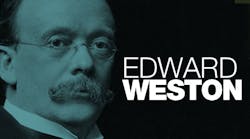From the time he took his first job in America at a metal plating factory in 1870 until his death in 1937, Edward Weston strove for perfection. "The fact is that Weston never did and never could relax mentally," wrote David Woodbury in his book, A Measure of Greatness: A Short Biography of Edward Weston. "His preoccupation with whatever he happened to be doing was vast and devastating... His drive to accomplishment was grim and sometimes brutal."1
That drive, though, amounted to a lot. Over the course of his 86 years, Weston obtained more than 300 patents, helped to lay the foundation for the Newark Technical School (now the New Jersey Institute of Technology), founded the Weston Electrical Instrument Company, and was awarded the prestigious Lamma Medal, among other accomplishments.
Weston was born in 1850 in Shropshire, Oswestry County, England. His father, an influential merchant, wanted his son to become a doctor. Weston went to medical school, but he had no desire to enter the medical profession. His education in chemistry became the base on which the young mind would take a look at life and decide he had to fix it.
While Weston may have come to the U.S. in search of opportunity, he had a hard time finding a job when he arrived in New York City in 1870. Broke and bewildered, he took a job with a metal plating company.
It didn't take long for the young immigrant to find something to perfect. Frustrated at the inefficiencies of the batteries the company used for electroplating, Weston started to search for a more efficient power source to get the job done. Not only did he find a better source, the generator, he also came up with one of the best electroplating dynamos in the industry.
Soon after Weston put the finishing touches on his dynamo in 1872, the 22 year old started his first business with his friend George Harris. It was at Harris and Weston that he would begin work on the early instruments that would later become the basis for the voltmeter, watt meter, and ammeter.
By 1877, Weston had opened his own dynamo business, the Weston Dynamo Machine Company, in Newark, N.J. Within a year, Weston's dynamo, which had a laminated iron armature and a magnetically efficient cylindrical design, received the bronze medal at the 1878 Paris Mechanical Exposition.2
Taking on Thomas Edison
Shortly before Weston opened his dynamo company, he received a patent for a dc generator. Work on generators continued at Weston Dynamo, where the now seasoned inventor started work on arc lighting. Meanwhile, Thomas Edison, who had just opened the Edison Electric Company in 1878, was starting work on his incandescent light bulb. While Edison experimented with natural substances in his search for a filament with a long bulb life, Weston looked to synthetic materials.2
In September 1882, Weston received a patent for his Tamidine filament, which had a 2000-hour life span. The Tamidine filament would remain the industry standard until 1906, when General Electric introduced the tungsten filament.
While the press may have begun to expect miracles from Edison,2 Weston felt no remorse in using the public arena to highlight his rival's shortcomings. Wrote John Anderson in his biography of Weston: "His confidence had already developed... to the point where he felt no qualms about taking on Edison. In the 1 November 1879 issue of Scientific American... he wrote, 'I can scarcely believe it as possible that the article on the above subject \\[Edison's dynamo\\] in the last week's Scientific American could have been written from statements by Mr. Edison himself, inasmuch as so many of the advantages claimed for the machine described and statements of the results obtained are so manifestly absurd.'"3
Creating a standard
Weston may have trumped Edison with the Tamidine filament, but he didn't linger on incandescent lighting. Another business venture, the Weston Electrical Instrument Company, opened in Newark in 1888. Weston then began work on the first truly permanent magnet, the basis of his work toward creating the voltage standard of the time.
In 1911, the National Bureau of Standards declared Weston's saturated cadmium cell— which could produce a voltage in the range of 1.0183 V—the standard for electromotive force. The Weston Saturated Cadmium Cell remained the standard for almost a century to calibrate other meters. Curiously, Weston, who historians note would often go to battle for his patents,3 waived his patent rights shortly after his cadmium cell became the standard.
Giving back to the community
For the more than 10,000 students who attend the New Jersey Institute of Technology today, Weston Hall may be just another building on campus. Yet many of those students may not realize that Weston was one of the first benefactors of the research institution.
"He worked tirelessly to support the creation of the Newark Technical School in 1881 and served on the board for six years," Woodbury said. "He firmly believed in the idea of educating others in the practical methods of engineering—a field that grew as a result of his own inventions."1
Weston died on August 20, 1936. He is still remembered today for his countless contributions to electrical measuring instruments.
References
- Woodbury, D., A Measure of Greatness: A Short Biography of Edward Weston
- Olsen, K., "Who Invented the Twisty Little Bit of Wire Inside the Light Bulb?" The Indicator, June 3, 2005
- Anderson, J., "History and reflections on the way things were," IEEE Power Engineering Review, November 2001
